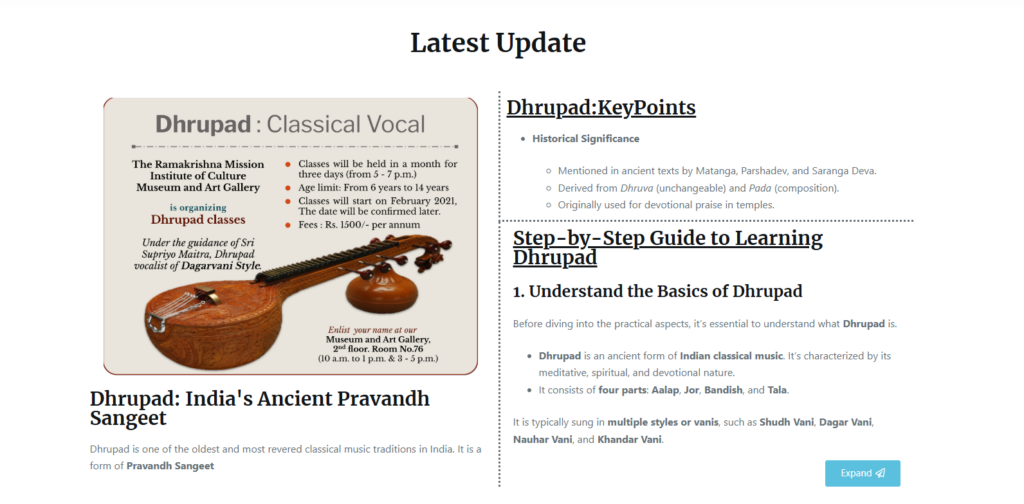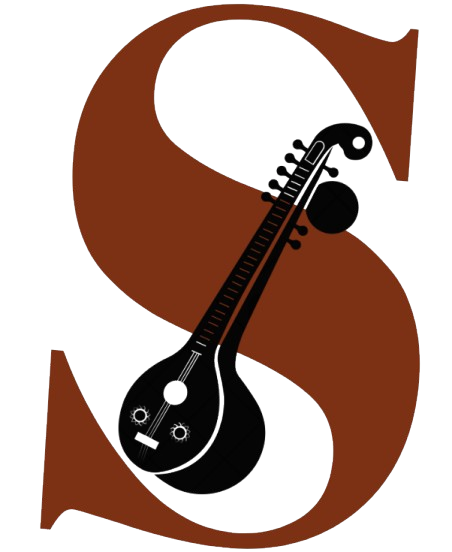Dhrupad: India's Ancient Pravandh Sangeet
Introduction
Dhrupad is one of the oldest and most revered classical music traditions in India. It is a form of Pravandh Sangeet (composed lyrical song), with roots in devotional and spiritual expression. Dhrupad music, historically used in temples to praise the divine, continues to hold significant importance in the classical music community.
Image: A classical Dhrupad performance
Historical Significance
Dhrupad has a rich historical background with references in ancient texts by musical scholars like Matanga, Parshadev, and Saranga Deva.
Origins and Early Development
- Term “Dhruvapada”: The word “Dhrupad” is derived from two Sanskrit words: Dhruva (unchangeable) and Pada (literary composition). In the early years, Dhrupad compositions were dedicated to praising the attributes of God, known as Dhruvapada.
Image: Ancient manuscripts referring to Dhruvapada
Evolution of Dhrupad:
Raja Man Singh Tomar’s Contribution
In the 15th century, Raja Man Singh Tomar of Gwalior, along with his wife Mrignayani, played a pivotal role in the revival and nurturing of Dhrupad. Their contributions include:
- Introduction of local language in the lyrics (Gwalior language).
- Creation of locally composed ragas.
- Broadening the emotional range to include themes like love and heroism.
Miyan Tansen and Modern Dhrupad
Miyan Tansen, a legendary musician at Emperor Akbar’s court, is often credited with shaping the present-day form of Dhrupad. His influence:
- Introduced formal compositions with structured tukas (sections).
- Established the association between Dhrupad and the pakhawaj (drum) as its main percussion instrument.
Image: Portrait of Miyan Tansen
Structure of a Dhrupad Composition
1. Abhog
- The Abhog serves as the introductory part of a Dhrupad composition, setting the tone and mood.
- Its melodic patterns combine improvisation with rhythmic movements.
2. Asthayee
- The Asthayee is the emotional core of the composition. It is the first primary section, often expansive, evoking deep emotions.
3. Antara
- Antara introduces variations to the Asthayee, expanding upon the musical theme and bridging the composition’s emotional progression.
4. Sanchari
- Sanchari represents the climax of the Dhrupad composition, marked by improvisation and the free exploration of melody, with a heightened emotional intensity.
Image: A diagram showing the stages of a Dhrupad composition
Rhythmic Cycles (Talas) in Dhrupad
Dhrupad compositions are accompanied by several Talas (rhythmic cycles). Some common talas include:
- Chautal (12 beats)
- Jhaptaal (10 beats)
- Surfaktal (7 beats)
- Brahmatal (5 beats)
The pakhawaj drum provides the percussion, often in sync with the Aalap (slow improvisation) and Jor (medium-paced rhythm) before the composition’s main performance.
The Four Styles of Dhrupad (Vanis)
1. Shudh Vani
- Origin: Gwalior, home of Tansen.
- Characteristics: Focuses on pure melodies with minimal ornamentation. The style prioritizes steady tempos and clear articulation.
2. Dagar Vani
- Origin: Village of Brijchand (Dagar).
- Characteristics: Incorporates technical ornamentations like Meend and Zamzama (fast gamak), creating intricate variations.
3. Nauhar Vani
- Origin: Nauhar, home of Rajput Srichand.
- Characteristics: Known for expansive note movements and alternating swar (notes). It is fast-paced, showcasing speed and dexterity.
4. Khandar Vani
- Origin: From Tansen’s son-in-law, Mistry Singh of Khandahar.
- Characteristics: Focuses on leisurely pace, graceful oscillations (Gamak), and medium-to-fast tempos.
Image: A chart showing the four Vanis
Conclusion
Dhrupad continues to be an essential and respected tradition in Indian classical music. Its layered compositions, spiritual depth, and historic significance make it a musical treasure. Each Vani style brings a unique flavor to Dhrupad, enriching the overall tradition and ensuring its timeless relevance.
Image: A live Dhrupad performance

Dhrupad:KeyPoints
Historical Significance
Mentioned in ancient texts by Matanga, Parshadev, and Saranga Deva.
Derived from Dhruva (unchangeable) and Pada (composition).
Originally used for devotional praise in temples.
Evolution of Dhrupad
Raja Man Singh Tomar (15th century) modernized Dhrupad by:
Introducing local languages in lyrics.
Composing new ragas.
Expanding themes beyond devotion to love and heroism.
Miyan Tansen (Akbar’s court musician) shaped its modern form by:
Standardizing structured compositions.
Establishing the pakhawaj (drum) as the main percussion instrument.
Structure of a Dhrupad Composition
Abhog – Sets the melodic and emotional tone.
Asthayee – The primary and most emotional section.
Antara – Expands on Asthayee with variations.
Sanchari – Climax with improvisation and melodic exploration.
Rhythmic Cycles (Talas) in Dhrupad
Common Talas:
Chautal (12 beats)
Jhaptaal (10 beats)
Surfaktal (7 beats)
Brahmatal (5 beats)
The Four Vanis (Styles) of Dhrupad
Shudh Vani – Pure, steady melodies.
Dagar Vani – Ornamented with Meend & Zamzama.
Nauhar Vani – Fast-paced with note variations.
Khandar Vani – Slow, graceful oscillations.
Conclusion
Dhrupad remains an important part of Indian classical music.
Its unique styles and structured compositions ensure its continued legacy.
